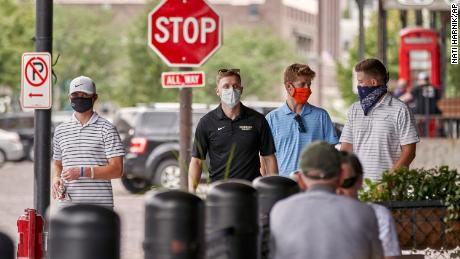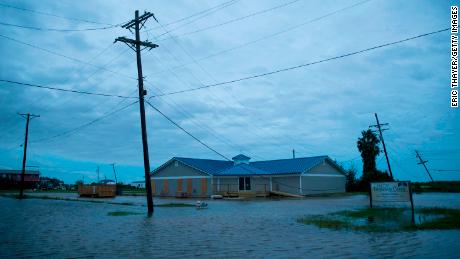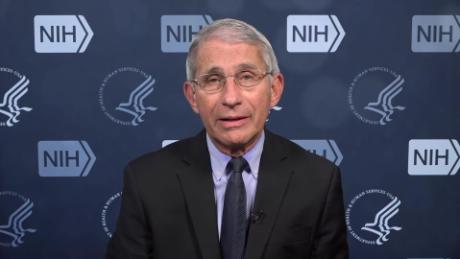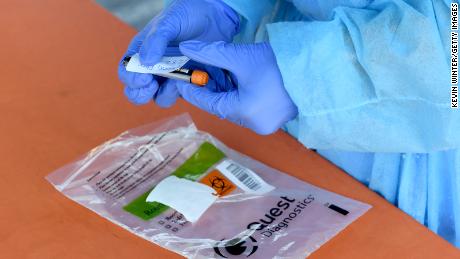(CNN)New coronavirus cases are down across the US about 12% on average over the last seven days compared to the previous week, but the nation is still averaging more than 900 deaths a day.
According to an analysis of data from Johns Hopkins University, cases are steadily declining in states hard-hit by Covid-19. Compared to last week, new cases are down in Arizona about 36%, California and Texas have seen a decrease of 29%, and Florida's numbers are down 26%.
But new cases are rising across the Midwest, including in Indiana, Iowa, Kansas and North Dakota, each of which is experiencing its peak seven-day average for daily new cases.
North Dakota claimed the mantle of the state with the highest per capita rate of new cases in the US with a seven-day average of 28.10 new cases per 100,000. Iowa and Kansas both saw record highs Wednesday for new cases reported.
Also on Wednesday, the US reported 44,109 cases and 1,222 deaths, according to Johns Hopkins.
The number of deaths related to the coronavirus in the US topped 180,000 on Thursday, according to the JHU data. More than 5.8 million cases have been reported.
Pandemic response complicated by Hurricane Laura
States hit hard by Covid-19 like Texas and Louisiana are dealing with another threat: Hurricane Laura made landfall overnight as a Category 4 storm with 150 mph winds. Each crisis has complicated the states' responses to the other.
Ahead of the storm, some Covid-19 testing sites were closed and efforts paused, likely hampering data collection in the coming days. But the pandemic also hobbled evacuation efforts as residents were worried about seeking refuge in shelters filled with large groups of people.
"We heard that early on from a lot of people, they were fearful of being put into a large shelter," Louisiana Lt. Gov. Billy Nungesser told CNN Thursday morning. So instead, people were sheltered in hotels, Nungesser said, where they could remain safely isolated away from other families.
"I think that was a wise move at FEMA to support those moves to hotels instead of large shelters," Nungesser said. "It helped a lot of people make the decision to get out."
Looking ahead, Nungesser said that the pandemic will also complicate relief efforts, particularly for residents who might have been displaced by the storm.
More of CNN's coronavirus coverage
"We are still dealing with the Covid-19 so finding housing for people is going to be a challenge," Nungesser said.
Meantime, Texas Gov. Greg Abbott said his state was also relying on new evacuation strategies that were tested last month by Hurricane Hanna, which brought heavy rains to southern Texas.
As many residents as possible were evacuated to hotels, Abbott said, instead of large spaces like convention centers.
"It worked every well in the aftermath of Hurricane Hanna because several weeks after ... the number of people testing positive for Covid-19 and the hospitalizations for Covid-19 actually declined," he said.
New CDC testing guidelines perplex doctors
Updated guidance from the US Centers for Disease Control and Prevention this week says some people without Covid-19 symptoms may not need to be tested, even if they've been in close contact with someone who has a confirmed case.
The CDC previously said testing was appropriate for people with recent or suspected exposure, even if they were asymptomatic.
The new guidance raised eyebrows among doctors who told CNN it didn't make sense.
"These are exactly the people who should be tested," said Dr. Leana Wen, an emergency physician and public health professor at George Washington University and former Baltimore health commissioner.
"I'm concerned that these recommendations suggest someone who has had substantial exposure to a person with Covid-19 now doesn't need to get tested," she said. Testing these individuals it "key to contact tracing," she added, since so much virus transmission is due to people who are not exhibiting symptoms.
Officials from the World Health Organization said the opposite to the CDC on Thursday, emphasizing the importance of expanding testing for those who have had contact with someone who has the virus and finding people with no symptoms.
"We have recommendations to test suspect cases, and in situations where it is feasible and is possible, to expand testing where necessary to really look for the cases so that they could be isolated and contact tracing can ensue," Maria Van Kerkhove, WHO's technical lead for Covid-19, said Thursday.
Also on Thursday, leaders of the Association of American Medical Colleges said they were "alarmed" by the "irresponsible" changes to the CDC testing duielines.
"This recommendation is irresponsible when we know that roughly 40% of SARS-CoV-2 transmissions come from an asymptomatic person," AAMC Chief Scientific Officer Dr. Ross McKinney Jr. and AAMC President and CEO Dr. David Skorton said in the statement.
"These CDC guidelines go against the best interests of the American people and are a step backward in fighting the pandemic," the statement said.
While not testing may be alright in some circumstances, there are others where it's necessary, said Dr. Carlos del Rio, infectious disease specialist and associate dean of Emory University School of Medicine. For example, if you've been in contact with someone who's not wearing a mask for 15 minutes.
"We don't want to decrease the amount of testing," del Rio said. "We want to decrease cases by decreasing transmission, not by decreasing testing."









